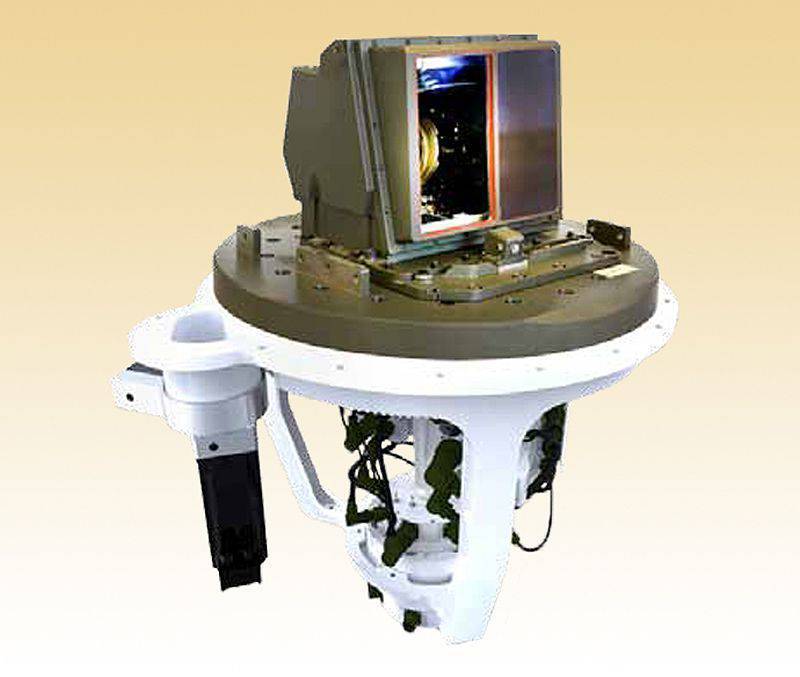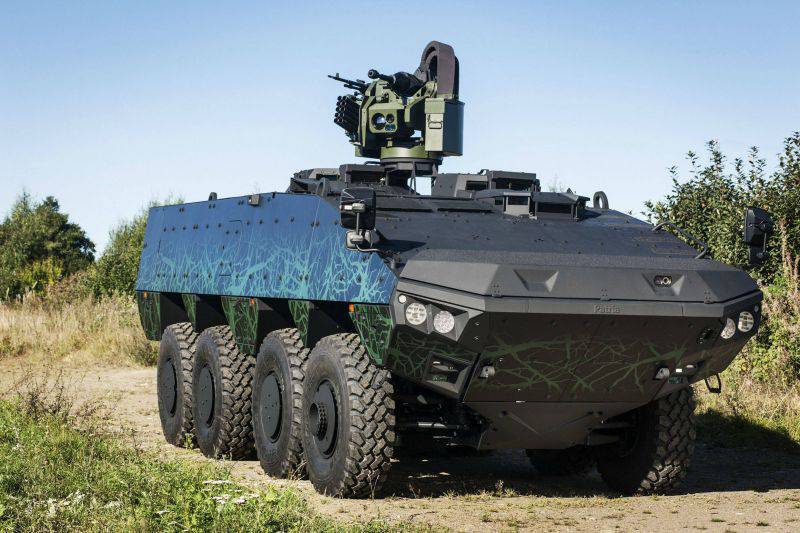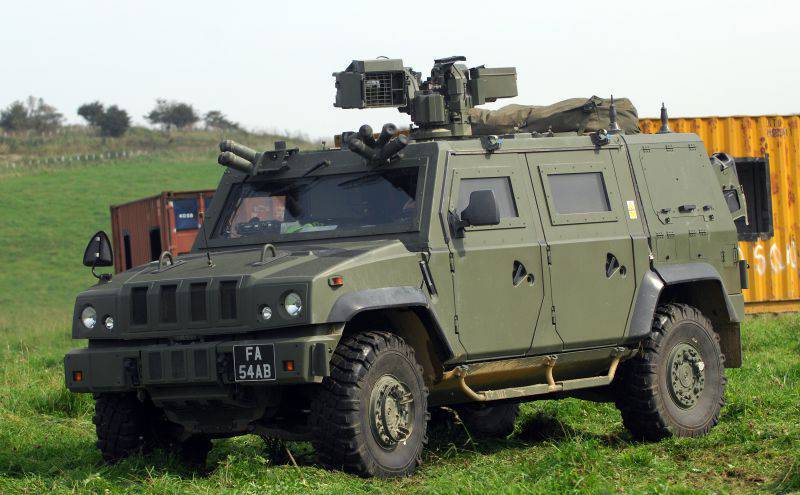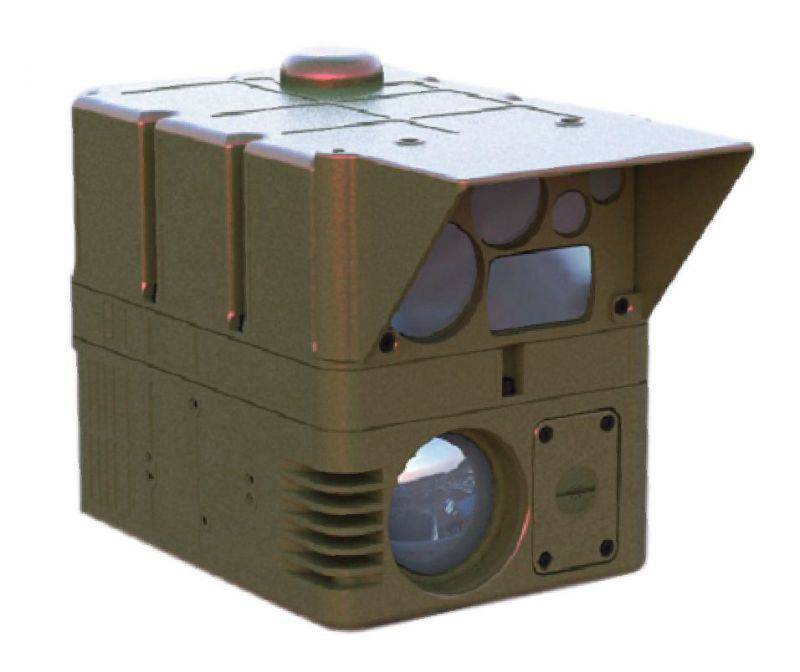Target capture strategy
Recent conflicts have demonstrated the importance of infrared sensors, high-resolution daytime cameras and laser technology.
A good overview and short reaction time are very important for capturing a target and aiming at it from the inside of an armored vehicle. Consider some of the existing Western development.
Many armored combat vehicles (BBMs) are now equipped with the so-called “triad of possibilities”, consisting of a thermal imager, a day-camera with a magnification and a laser rangefinder safe for the eyes, which provides target data to the fire control system (FCS).
These capabilities allow new and existing platforms to quickly identify targets and effectively hit them. They also reduce the time that the crew spends on peeping out of hatches and doors, while it, being outside the protected limits of the vehicle’s armor, exposes itself to mortal danger.
The key technological trend in new aiming systems is to increase the number of pixels in surveillance devices, which means obtaining images with higher resolution and, accordingly, increased detection, recognition and identification distances. Ground-based machines currently benefit from the use of high-definition images, which previously only aerial platforms could "boast". This is mainly due to the fact that the cost of technology has decreased significantly, just like in the case of household TVs.
Recent conflicts in Iraq and Afghanistan have shown that infrared sensors, day cameras and lasers on stabilized and unstabilized platforms are more important than ever.
Yours or someone else's
Manufacturers are very closely watching the main trends in the development of systems for vehicles, see the demand for increased range, higher resolution images and increased capabilities of laser systems, such as target designators.
“When it comes to modern asymmetrical combat scenarios, for example, in Afghanistan and Iraq, the earliest possible identification of one’s own or an opponent becomes all the more important,” said a spokesman for Airbus DS Optronics. “We are also working to improve color reproduction with a view to significantly simplifying target identification and increasing situational awareness.”
Airbus DS Optronics supplies stabilized optical and optoelectronic equipment for the Puma BMP, currently manufactured for the German army. The basis of the sighting and observation complex is a stabilized panoramic periscope for the commander Peri RTWL (Rundblick, Tag Warme, Laser - all-round visibility, day, heat, laser) and an optical-electronic aiming system for the EOTS (Electro Optical Targeting System).
Both EOTS and Peri RTWL systems incorporate a gyroscope-based stabilizing mechanism that provides a stable and continuous image even when driving on rough terrain.
Peri RTWL has four operating modes: independent orientation, regardless of the position of the gun; viewing mode, when the periscope is synchronized with the instrument; target designation mode, when the instrument is synchronized with the periscope; and position on 6 or 12 relative to the central axis of the machine. The periscope also allows the commander to transfer the arrow marked targets day and night, thus separating target designation and target acquisition.
EOTS and Peri RTWL systems incorporate an advanced third-generation thermal imager with a two-dimensional infrared matrix on CMOS structures, designated ATTICA (Advanced Thermal imager with Two-dimensional IR CMOS Array), a high-resolution CCD camera and a laser-safe laser rangefinder. The ATTICA thermal imager generates analog and digital video signals that are compatible with CCIR and RS-170 standards for displaying images on television monitors and various VESA standards (up to SXGA and 1280 x1024).
ATTICA was proposed in 2013 year as the standard for the sighting of the commander Peri R17; it provides better image quality compared to the previous Ophelios model of the same Airbus DS Optronics company. These stabilized systems can also be integrated into other machines.
The British Army Panther communications and control machine is equipped with the STAWS system from Selex
Issuance of contracts
In 2014, Airbus DS Optronics won a contract worth approximately € 40 million from Krauss-Maffei Wegmann and Rheinmetall Defense Electronics for the supply of optoelectronic equipment. This contract provides for the integration of optical and optoelectronic equipment into vehicles purchased by customers from the Middle East, including the main combat Tanks Leopard 2A7 +, PzH 2000 self-propelled howitzers and Wisent armored recovery vehicles.
“With shrinking defense budgets, we focus on form-fit-function solutions (form, compliance and function) for modernization markets in the Western Hemisphere, especially for upgrading Leopard tanks and focusing on new markets in fast-growing economies,” continued the representative of Airbus DS Optronics . - Shrinking budgets lead to a longer lifetime of the systems. Tanks Leopard or Abrams will remain the most significant MBT in the Western world. In addition, new BMPs are emerging. ”
The 2014 contract of the year included the supply of a Peri RTWL commander's periscope, sensors for the EMES 15 arrow sight, and a FERO Z18 auxiliary sight tube. When a target is captured by a periscope, information about it is transferred to the tank's MSA. When combined with the MSA, these sensors ensure accurate target designation and a high probability of hitting from the first shot.
Airbus DS Optronics also received a contract in 2014 for the cost of upgrading more than 15 MBO Leopard 100 in Canada, Denmark and Germany in 2 million euros. Recent contracts have strengthened the company's position as one of the leading suppliers of stabilized periscopes and optical-electronic weapons sensors for Leopard family tanks.
Growing markets
One of the leaders in the market of optical-electronic systems for vehicles, the French company Thales, also has in its portfolio a large range of surveillance and guidance systems for armored platforms. Richard French, head of the development of optical-electronic systems for land and offshore platforms, said he sees strong growth in the markets of Asia, India and the Middle East, as well as stable or small growth in Europe and North America.
Thales' independent, stabilized, panoramic sighting system Orion was selected for the Scout SV program of the British Army. The company also produces a family of day / night sights for shooters and DNGS (Day / Night Gunner and Panoramic Sight) panoramic sights, created and selected for a number of platforms, including the Scorpion 90, VBCI, BMP series, CV90 series, VAB and Russian and Ukrainian armored vehicles. .
The Malaysian company DefTech has integrated the Thales DNGS T1 system along with the Catherine XP thermal imager into its new BBM AV8. The newest model DNGS T3 is a complex with electronic stabilization (regardless of the instrument), which allows the implementation of the so-called search and shock function.
French explained that these new stabilized systems also allow vehicle crews to conduct electronic tracking of targets and provide some semi-automatic detection capabilities, reducing the burden on crew members.
The LOTHAR (Land Optronic Thermal Aiming Resource) day / night sight from Selex ES is popular in the Italian army. It was also installed in the Hitfist Plus tower of Ola Melara on the Freccia 8x8 BMP manufactured by Iveco and OTO Melara. According to Selex ES, the LOTHAR 35 kg can either be attached to a gun or stabilized independently. LOTHAR can also be integrated as a key component of the OMS of a machine operating guns of calibers from 25-30 mm to 120-125 mm.
The system includes the latest thermal imaging modules from Selex ES, including TILDE and ALICE sensors operating in the near [long wavelength] IR region of the spectrum and ERICA FF sensors operating in the middle IR region of the spectrum, all with a matrix size of 768X576; Color CCD camera with a resolution of pixels 752x582; eye-safe laser rangefinder with a working wavelength of 1.54 micron; and daily periscope.
New opportunities
Selex ES, which also manufactures the THETIS, ATTILA-D and TURMS-D systems, performed several contracts in the local and foreign markets for the supply of optical-electronic systems, both for new machines and for upgrading existing platforms.
“The current technologies provide us with many opportunities in connection with the development of new generation thermal imaging detectors,” said a company spokesman, noting that “the use of FPA detectors eliminated the need for outdated technology, such as scanning mechanisms, mirrors and other auxiliary items.
This simplification has led to increased reliability and reduced size and weight, as well as reduced costs for the manufacture of thermal imagers. Third-generation detectors are currently a consolidated technology and current efforts are focused on developing new and more powerful FPA arrays, reducing pitch and increasing the number of pixels in the matrix itself, capable of generating high-resolution images.
Another accurate target designation from Selex is the Colibri day / night MSA. The system includes a sensor head, which includes a third-generation ERICA FF thermal imager, a 795x596 television CCD camera, a laser rangefinder and eye control system for the laser control system; All this in a strong compact unit weighing 15 kg. Its open architecture allows for customizations to be implemented, including full graphical overlap, gunner action duplication for the commander, and advanced ballistic calculations.
Many manufacturers are currently offering integrated systems for combat modules, including Thales and its Kate all-in-one sensor unit.
In the service
Sagem is also a key player in the surveillance and aiming systems market. The company's two flagship products in the main arrow category are Savan 11 and Savan 15.
The Savan family of sights was installed on the Leclerc MBT of the French and Emirate armies. The Savan 11 and Savan 15 sights have direct optical channels; 3-5 or 8-12 micron thermal imagers with two optical magnification and digital zoom; as well as color cameras with two fields of view. In order to increase the probability of damage from the first shot, the sights also incorporate a laser rangefinder safe for the eyes.
The Savan 11 system was designed for BMPs, either as original equipment or as an upgrade to average life expectancy; It offers high aiming accuracy and automatic acquisition of target parameters (including distance, angular position, relative speed) for calculating lead angles. The system consists of two main devices: the integrated two-axis stabilized day / night optical-electronic sight LST 11 and the auxiliary day sight LJ 11.
Savan 15 system is designed primarily for the MBT market and is designed for firing ranges over 2,5 km with a probability of hitting 90% from the first shot. Sagem says that this product, intended for firing on the move, consists of modular units, including a primary day / night gunner, a ballistic computer, sensors for stabilizing weapons, sensors for automatically calculating lead angles and on-site man-machine interfaces commander and arrow.
Sagem also offers PASEO (long-range) and MPS (medium-range) stabilized sights. Panoramic sight PASEO is an independent two-axis stabilized direct vision system for BMP and MBT, it is intended for shooter and commander and guns with 30-125 caliber mm. With this system, targets can be determined at a distance of about 12 km, and the optional automatic tracking function for the target increases the firing efficiency of the platform.
For new and existing armored vehicles, the MPS family of sights weighing about 20 kg offer day and night channels, as well as targeting and target acquisition functions. Merging images from the day and night branches increases target detection capabilities, and customers can take advantage of uncooled or cooled thermal imagers, the latter having long identification ranges.
Elbit Systems installs its OWNS Knight on Israeli Merkava tanks; the integration of this system greatly simplifies observation and targeting. The system is characterized by two-axis stabilization, computer image processing with a sight, automatic tracking of targets and the possibility of firing in motion.
Remote capabilities
In recent years, the number of sighting and surveillance systems for remotely operated combat modules (SDMs) has also increased, reflecting the increasing use of them in theaters such as Iraq and Afghanistan. Most of the major manufacturers of optoelectronics in Europe and other countries have developed sighting systems specifically for DBMS.
“We have an interest in all machines with an installed OAK,” said French.
Thales has a rich history production of uncooled thermal imagers for original SDMs, including the TIM (Thermal Imager Module) system family. In uncooled TIM systems, microbolometer arrays of 640x480 pixels and 17 micron pitch can be used, as well as larger advanced XGA 1024x768 matrices with 17 micron pitch. The latest technology is becoming increasingly popular with manufacturers of original modules. Thales has also begun to offer complete solutions for the DBMS, and not just individual components.
“Some manufacturers of original products like to use a separate laser range finder, a separate thermal imager and a separate daytime camera,” explained French.
Moving forward, Thales is offering a new sensor for an OCBM under the name Kate, in which the thermal imaging camera, day camera and laser range finder are integrated into one unit; this makes it easier to integrate into the original SDS.
The Kate all-in-one integrated touch unit was introduced in 2013. In the 10 kg unit, either a cooled thermal imaging technology (LR variant) or an uncooled technology (TR variant) is used. It is fully calibrated and calibrated for the DBMS. Thales says that Kate has become a “very successful” product, over a thousand systems have already been sold and in the future the company expects to supply from 400 to 500 systems per year.
Kate LR can identify vehicles at a distance of up to 18 km and dismounted soldiers by about 10 km and allows you to identify tanks or soldiers at ranges of 3,3 km and 1,5 km, respectively.
The company Thales says that “if before we supplied the imager, day camera and laser range finder separately, now we combine them. We are very flexible in technology, Kate system interfaces are customizable; they can be digital for new cars, as well as analog if we are upgrading existing machines. ”
Specialized systems
FLIR Systems has also developed an aiming complex specifically for the market for the use of the double-faced SDM, which received the designation ThermoSight RWS-M. An uncooled 640x480 thermal imager, a camera that can identify a tank at a distance of 2,5 km, and a diode laser capable of measuring distances up to 4,5 km are integrated into the system. The ThermoSight RWS-M complex was installed on several DBMSs, including Saab TrackFire, Köngsberg Protector, FN Herstal CeFNder, BAE Systems Bofors Lemur, as well as self-propelled artillery and mortars.
As part of the 11 million-dollar program signed in 2012 with BAE Systems Hagglunds, the ThermoSight LIRC sighting system and SA90 and DV55 thermal imagers for the driver and other crew members from FLIR were selected for installation on the CV9030 BMP.
One of the newest products of FLIR Systems is the TacFLIR 280-HD fully digital reconnaissance and surveillance system, which includes the usual triad: a high-resolution imager, a day camera with a resolution of 1920x1080 and a laser range finder with a range of 30 km. 15 kg device to increase situational awareness or control of combat modules, as well as target detection and capture.
“The TacFLIR 280-HD provides real opportunities for longer observation and reconnaissance that were not available in systems of similar size. Therefore, we integrate these capabilities, which were usually reserved for larger platforms, or even aircraft, in sizes when light tactical vehicles and small armed vehicles can have exactly that level of situational awareness, ”explained the head of the surveillance systems department at FLIR Systems Andrew Saxton.
“Since the military around the world are expecting more and more network capabilities, and for each machine they are performing an ever wider range of tasks, we really see that the surveillance and intelligence component is starting to play an increasingly important role when these machines perform combat missions.”
Indirect vision
Selex ES developed the opto-electronic OMS for indirect vision and gave it the designation Mini Colibri. Like sighting systems on larger platforms such as BMPs and MBTs, it can capture targets around the clock and in any weather. At Selex, the Mini Colibri system is well suited for small and medium-sized weapons systems. It was integrated into the OEDS installed on Italian Iveco Lince 4x4 (LMV) multi-purpose light vehicles.
Selex ES also supplied the STAWS (Surveillance Target Acquisition and Weapon Sight) STAWS surveillance and targeting system for the British Army Panther communications and control vehicle (based on the Iveco LMV). It can be integrated with the DBMS Enforcer II; it detects vehicles at a distance of 7,5 km. This system was created “with an eye to the future” in order to be able to adopt larger uncooled thermal imagers and more accurate targeting technologies, such as the digital compass and the GPS system.
In turn, the CM3 MR 8 kg system from Sagem was integrated into the FN Herstal DeFNder Light combat module. This combat module is installed on the version of the command post VPC (Vehicule Postede Commandement) BMP Nexter VBCI (Vehicule Blinde deCombat d'lnfanterie) of the French army.
The CM3 MR system is available with two microbolometer arrays of 640x480 or 384x288 pixels, the latter capable of detecting a crowd of people at a distance of 4 km and a tank on 6,8 km. The aiming system can combine images from the day camera and thermal imager to increase the distance to capture targets, while digital image stabilization allows you to observe while the vehicle is moving.
Synergistic awareness
As the vehicle architecture evolves, it is likely that a tighter integration will be realized between the vehicle's aiming systems and other imaging technologies, such as surveillance and reconnaissance systems, the driver review system and situational awareness sensors. This is what Saxton called the "integration of the three systems into one synergistic awareness system."
“One of the serious problems is the load on the operator, when under the burden of a multitude of tasks his potential is quickly exhausted. Therefore, I believe that in the future we will see an interconnected system that adapts to the needs of the operator, but everything works as a single whole. ”
One of the driving forces here could be the GVA (Generic Vehicle Architecture) architecture, which is installed on promising armored vehicles of the British army.
“If we add a new open GVA architecture that simplifies the configuration of various types of solutions, this will allow us to get exceptional flexibility in our offerings for several types of systems,” said a representative of Selex ES.
Mr. French believes that as part of future upgrades, the value of GVA will increase as the machines become multi-tasking platforms. It will allow them to automatically connect sensors and systems in accordance with the specific requirements of the task. At Thales, he also sees the prospect in smaller and lighter vehicles that receive more firepower and combat capabilities, which in turn means an inevitable increase in the performance of the surveillance and aiming systems.
There is also a tendency towards dual use of the Dubmarin, when it will also be used as a commander’s viewing instrument. Often, this means a more powerful thermal imager with a range that exceeds the actual range of the weapon installed in the DBMS.
“If we look back a decade ago, we will see that the customers then wanted to identify targets at a distance of 2 km, and now they also want to identify targets at a distance of 5 km,” added a representative of Selex ES.

Thales believes that the Orion complex, chosen by the British army for its Scout SV program, is the first fully digital system on the market
General approach
Stabilized independent panoramic complex Thales Orion was selected for the program of the British army Scout SV on the next generation reconnaissance vehicle. Orion was first introduced at DSEi 2011; It is equipped with a Catherine MP thermal imaging camera and can rotate continuously on 360 °. He was qualified to install both tracked and wheeled vehicles.
Orion is designed to integrate into the common standard vehicle architecture GVA Scout, which uses a Gigabit Ethernet interface for data and video transmission, which is “easily upgraded and easily integrated.” Thales believes that this is the first fully digital system on the market. The GVA architecture is specifically designed to handle large, high-resolution images that are generated by third-generation surveillance and aiming systems, such as the Orion.
GVA will also be an addition to the British Army's BMP Warrior, undergoing upgrades to extend its service life. Thales will supply aiming and surveillance systems for upgraded Warrior machines, but refuses to comment on specific systems.
The GVA technology has good potential in the sense that it allows the commander, the gunner, the driver, and in the case of the BMP and the landing party, to see one picture in all the compartments of the vehicle. Other features of the Orion system include: the choice of thermal imagers LWIR (near infrared spectrum) and MWIR (middle infrared spectrum), two television sensors (long-range and wide-angle), high-resolution video output and automatic integration with the electronic architecture of the machine.
Materials used:
www.shephardmedia.com
www.defenceandsecurity-airbusds.com
www.thalesgroup.com
www.sagem.com
www.flir.com
www.selex-es.com
www.wikipedia.org
www.baesystems.com



Information